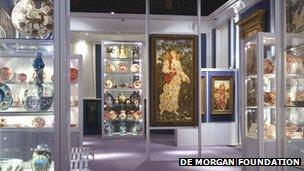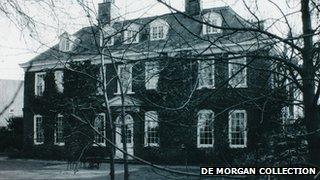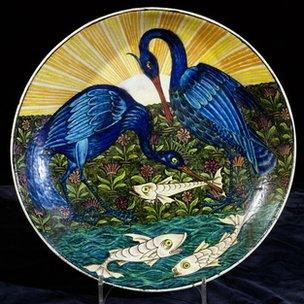Wilhelmina Stirling's Battersea art collections on display
- Published
Mrs Stirling on whether there are ghosts in her house
Immortalised by a Ken Russell short film, Mrs Wilhelmina Stirling was one of Battersea's most eccentric and well-loved residents.
Now, the story of her life and her remarkable collection of Victorian art, once housed in the historic Old Battersea House, are featured in an exhibition as part of the Wandsworth Heritage Festival.
Much of Mrs Stirling's collection consisted of works by her older sister, Evelyn Pickering, a well respected member of the late Pre-Raphaelites, and Evelyn's husband, the potter and author William De Morgan.
She also collected paintings by other Victorian artists such as Rodham Spencer Stanhope, Holman Hunt and John William Waterhouse, and a sizeable collection of 16th and 17th century furniture.
'A living museum'
Her collection was entrusted to the nation and a large selection is preserved at the De Morgan Centre in West Hill, as Old Battersea House was deemed too expensive to maintain.

Most of the work at the De Morgan Centre comes from Wilhelmina Stirling's collection
A Grade II listed 17th century building, Old Battersea House was saved from demolition in 1931 by Mrs Stirling and her husband who persuaded the council to give them a life tenancy for a nominal fee if they opened their collections to the public.
"It was a living museum," says Claire Longworth, curator at the De Morgan Centre.
"Old Battersea House was continually full of friends and family who joined her for afternoon tea, or the visitors who regularly knocked on the door hoping for a tour of the house and collection."
Mrs Stirling lived in Old Battersea House for over 30 years. Her tours of the house could last as long as five hours and she continued to welcome visitors to her home well into her later years.
She died shortly before her 100th birthday in 1965.
Sir John Betjeman likened the atmospheric Old Battersea House to that of Miss Havisham's in Great Expectations, but the building also captured the imagination of film director Ken Russell who visited Mrs Stirling in 1960.

Old Battersea House was not designed by Christopher Wren, as Mrs Stirling sometimes suggested
Russell was inspired to direct a short film for the BBC television show Monitor, exploring Old Battersea House and its intriguing inhabitant, then aged 96.
Narrated by Huw Wheldon, its macabre portrait of the house was interspersed with highly comical monologues by Mrs Stirling about the alleged sightings of ghosts and the ideals of the Pre-Raphaelite movement.
The documentary was a success. According to Ken Russell's biographer, Paul Sutton, Mrs Stirling received such a high number of praiseworthy letters she had to employ a secretary to cope with them all.
Pankhurst letter
As well as being one of the most influential collectors and proponents of Victorian art, Mrs Stirling found time for progressive politics.
The exhibition includes a 1911 letter from Emmeline Pankhurst in which the suffragette thanks Mrs Stirling for unearthing a piece of evidence proving women had been able to vote in some instances prior to the Reform Act of 1832.
Mrs Stirling's lifetime's passion was focused on acquiring, exhibiting and protecting for posterity as much of her sister and brother-in-law's art as possible.
Evelyn De Morgan, as she became after her marriage, was one of the later Pre-Raphaelites.
Her paintings were in the Grosvenor gallery's inaugural exhibition in 1877, an important event in the history of the Aesthetic movement.

'Heron and Fish' dish by William De Morgan, who was influenced by the Arts and Crafts movement
De Morgan, who went to the Slade School of Fine Art in London, was one of the few women in the Pre-Raphaelite "brotherhood", in an era when being a professional artist was considered by many to be unladylike.
Her husband William showed his support by serving as vice president of the Men's League for Women's Suffrage in 1913.
He was also a ceramicist, a potter and received recognition later in life as a novelist.
Mrs Stirling was a prolific published author of more than 30 novels and historical accounts although she was said to be prone to fabrication, not least in her rather fanciful history of Old Battersea House.
Claire Longworth said: "Even now I regularly hear from people who have fond memories of trips to visit the eccentric lady and her wonderful home; descriptions of Mrs Stirling, frail, but elegant, bedecked in jewels and vibrantly dressed in purple or red velvet dresses, are now familiar stories to me."
The exhibition opens at the De Morgan Centre on 1 May and a screening of Ken Russell's film will take place on 6 June.
- Published11 September 2012